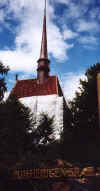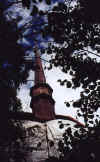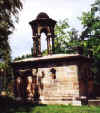|


| |
 |
Görlitz is a German town on the border with Poland.
Its15th-century replicas of the Calvary chapel and edicule (tomb of
Christ) from the Church of the Holy Sepulchre in Jerusalem are examples of
medieval piety centered in pilgrimages and the Passion of Christ. Photo A
is the entrance to the "Holy Grave" (Heiligen Grab).
The structures were built by Georg Emmerich, who made a pilgrimage to the
Holy Land in 1465 and on his return to his home town, had the replicas
built. During Holy Week, Christians would process from the nearby St.
Peter's Church, just as pilgrims in Jerusalem would process along the Via
Dolorosa. |
Facts and Photos
 While
there are 17 replicas of the edicule (the structure within the Church of the
Holy Sepulchre in Jerusalem over the tomb of Christ) in churches throughout
Germany, the Görlitz complex is unique because it includes copies not only of
the edicule but also of the Calvary chapel and anointing stone from the
Jerusalem church. The tall spire (photo B) tops the Calvary chapel; this is not
in imitation of the church of Holy Sepulchre, since the Calvary chapel there is
within the larger structure and is not a free-standing building. While
there are 17 replicas of the edicule (the structure within the Church of the
Holy Sepulchre in Jerusalem over the tomb of Christ) in churches throughout
Germany, the Görlitz complex is unique because it includes copies not only of
the edicule but also of the Calvary chapel and anointing stone from the
Jerusalem church. The tall spire (photo B) tops the Calvary chapel; this is not
in imitation of the church of Holy Sepulchre, since the Calvary chapel there is
within the larger structure and is not a free-standing building.
The two-story building (photo C, below right) has both Adam's chapel on the
lower floor and the Calvary chapel on the upper floor, as in Jerusalem. Photo D
(below left) shows all three structures, the Calvary Chapel on the far right
foreground, anointing stone in the center, and Edicule over the tomb in the left
background. The structures are positioned the same as in the church in
Jerusalem.
 The
edicule (photo E) is topped with a cupola as it was in the middle ages. It has
the same two-room structure as in Jerusalem, with a stone slab on the right hand
side in the inner room, just as the Jerusalem edicule. The
edicule (photo E) is topped with a cupola as it was in the middle ages. It has
the same two-room structure as in Jerusalem, with a stone slab on the right hand
side in the inner room, just as the Jerusalem edicule.
Robert Ousterhout, describing a similar site in Bologna, Italy, writes:
"Geography was a flexible concept in the Middle Ages. The `Jerusalem' in
Bologna wasn't simply a copy of the holy sites; it was believed that through the
combination of image, dedications and devotional acts, the sacred topography of
the Holy City could be relocated, re-created, as it were, at a new site. Bologna
could become Jerusalem. . . . The significance of Santo Stefano lay in the
belief that sanctity or spiritual value could be associated with persons, places
or objects, and that by being captured in matter, the numinous qualities could
be carried away from the original location. Such transfers of holiness were
common in the Middle Ages, although they were normally enacted on a smaller
scale than our Bologna example, and were a routine component of Christian
pilgrimage" (29). He summarizes later, "The Jerusalem imagery thereby
made spiritually present the life-giving powers of the Tomb of Jesus" (31). |
